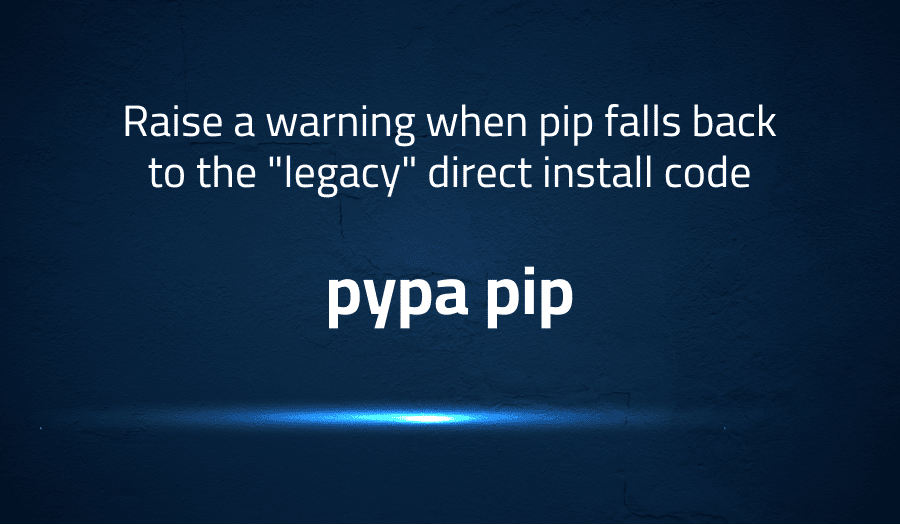

Raise a warning when pip falls back to the “legacy” direct install code in pypa pip
Explanation of the problem
The current legacy code (invoking setup.py install directly) utilizes setuptools for generating entry point wrappers which rely on pkg_resources at runtime and have been reported to be slow.
When pip uses the legacy code path setup.py install, a warning should be issued pointing out that the absence of the wheel library would result in the generation of old-style script wrappers by setuptools.
The proposed warning may appear noisy to some users but is crucial as the legacy code path will be eventually removed. The warning informs users of their usage of the legacy code path and prepares them for the future changes. The requirement for wheel to be installed is currently not well managed and the warning will increase visibility and trigger a more meaningful discussion on its management. The ultimate solution will be to fully adopt PEP 517 processing, but that will take time.
Troubleshooting with the Lightrun Developer Observability Platform
Getting a sense of what’s actually happening inside a live application is a frustrating experience, one that relies mostly on querying and observing whatever logs were written during development.
Lightrun is a Developer Observability Platform, allowing developers to add telemetry to live applications in real-time, on-demand, and right from the IDE.
- Instantly add logs to, set metrics in, and take snapshots of live applications
- Insights delivered straight to your IDE or CLI
- Works where you do: dev, QA, staging, CI/CD, and production
Start for free today
Problem solution for Raise a warning when pip falls back to the “legacy” direct install code in pypa pip
To raise a warning when pip falls back to the “legacy” direct install code path, the following steps can be taken:
- Check if the
pipis using the legacy code path by checking for the invocation ofsetup.py install. - If the legacy code path is being used, raise a warning message that informs the user that the absence of the
wheellibrary would result in the generation of old-style script wrappers.
if legacy_code_path_is_being_used:
print("WARNING: The wheel library is not present, so old-style script wrappers will be generated.")
This solution ensures that the users are aware of their usage of the legacy code path and can take necessary actions to avoid any potential performance issues.
Other popular problems with pypa pip
Problem: Inconsistent behavior with respect to dependencies
One of the most commonly encountered problems with pypa pip is inconsistent behavior with respect to dependencies. The dependencies for a package may be specified in the setup.py file, but pip may not always install the correct version or may install additional dependencies that are not specified.
Solution:
The solution to this problem is to use a requirements.txt file, which specifies the exact versions of all dependencies that should be installed. This file can be provided to pip with the -r or --requirements option to ensure that the correct dependencies are installed.
Problem: Incompatibility with virtual environments
pypa pip can sometimes have issues when used in virtual environments, such as not recognizing the virtual environment’s Python installation or not installing packages into the virtual environment.
Solution:
The solution to this problem is to use the --user option when installing packages with pip. This option causes pip to install the package in the user’s home directory, which is separate from the virtual environment and will not cause any compatibility issues.
Problem: Unresolved dependencies
Another common problem with pypa pip is unresolved dependencies, where a package fails to install because one or more of its dependencies cannot be found or installed.
Solution:
The solution to this problem is to use the --no-deps or --no-dependencies option when installing packages with pip. This option causes pip to only install the requested package and not its dependencies, allowing the user to manually resolve any dependency issues. Alternatively, the pip community maintains a list of “known good” package indexes that can be used to resolve dependencies, which can be specified with the -i or --index-url option.
A brief introduction to pypa pip
pypa pip is a package manager for Python that allows users to easily install and manage packages for their Python applications. It is designed to work with the Python Package Index (PyPI), a repository of over 200,000 packages that can be installed with pip. pip provides a simple command line interface for installing packages and managing dependencies, making it an essential tool for Python developers.
pip uses the information specified in a package’s setup.py file to install the package and its dependencies. The setup.py file contains information about the package such as its name, version, and dependencies, as well as any scripts or data files that should be installed with the package. pip also supports the use of requirements.txt files, which specify the exact versions of dependencies that should be installed. This allows developers to have precise control over the packages and versions that are used in their projects.
Most popular use cases for pypa pip
- Installing and managing packages from the Python Package Index (PyPI)
pypa pip can be used to install packages from PyPI, which is a repository of over 200,000 packages for Python. The pip install command is used to install packages from PyPI, for example:
pip install <package-name>
- Managing dependencies for Python projects
pypa pip provides a convenient way to manage the dependencies for Python projects. Packages can specify their dependencies in their setup.py file, and pip will automatically install those dependencies when the package is installed. This makes it easy to ensure that all dependencies are correctly installed and up-to-date.
- Creating and distributing Python packages
pypa pip can also be used to create and distribute Python packages. Developers can use the pip wheel command to create a wheel (a pre-compiled package) that can be easily installed with pip. This makes it easy to distribute packages, as users only need to run pip install to get the latest version of the package and its dependencies.
It’s Really not that Complicated.
You can actually understand what’s going on inside your live applications.




